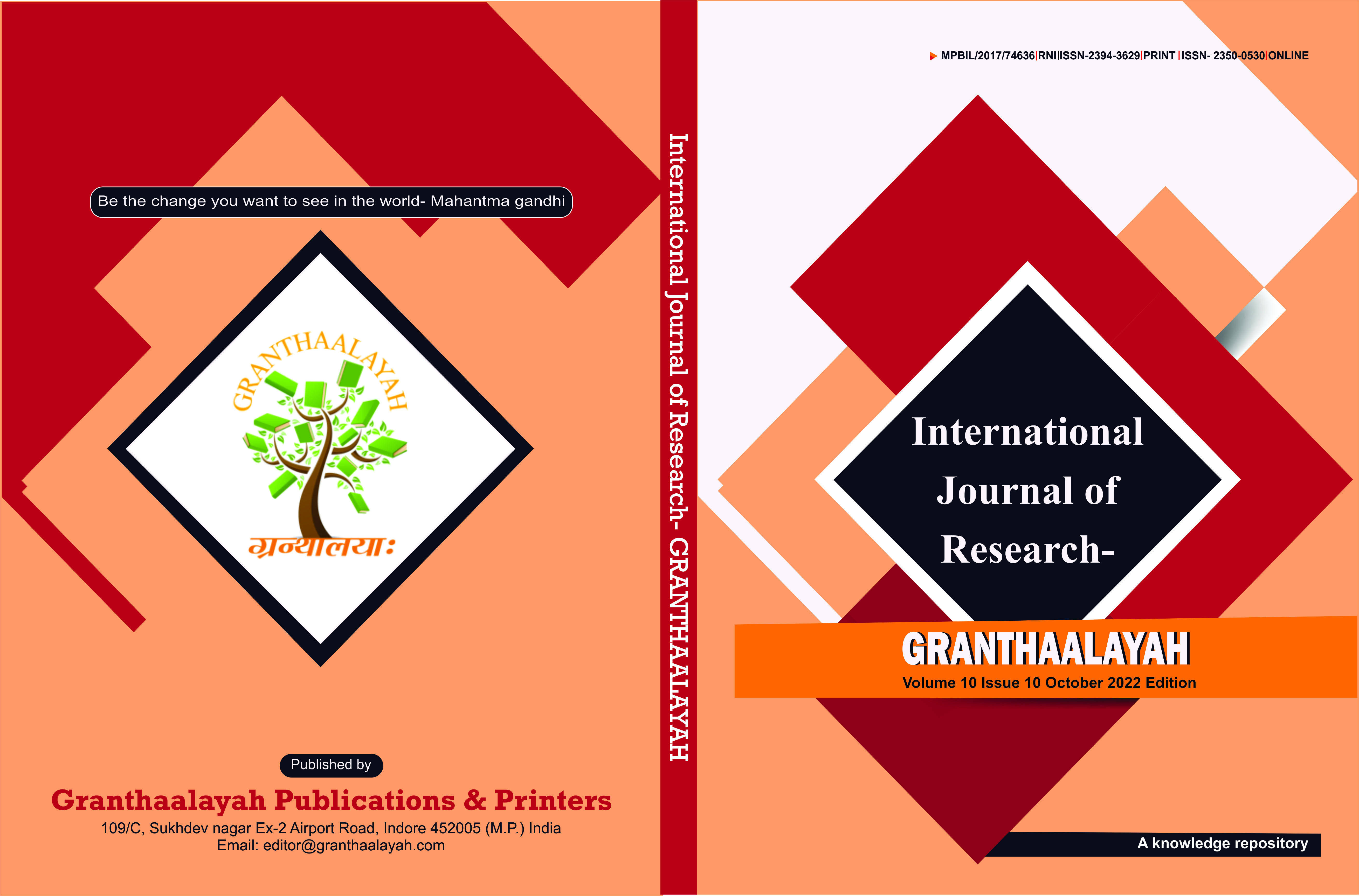TRIHALOMETHANES REMOVAL FROM DRINKING WATER BY HEATING: A CASE STUDY
DOI:
https://doi.org/10.29121/granthaalayah.v10.i10.2022.4728Keywords:
Chlorination, Disinfection By-Products, Drinking Water, Heating, TrihalomethanesAbstract [English]
Trihalomethanes (THMs) specially Chloroform is the most significant and well-known by-products of chlorine disinfection. In light of the alleged carcinogenic effects of THMs in drinking water, the goal of this study was to investigate the consequences of heating the chlorinated water, to lower its THM content, if any, in the drinking water of Dhaka. In this experiment, three individual samples from three separate locations in the same water supply system were investigated in 2019. Chloroform concentrations decreased noticeably (from 42% to 100%) due to heating during the trials. The results revealed that in sample 1, chloroform decreased from 199 to 79.7 20 μg/l (60% removal) after one minute of boiling of water, to 20 μg/l (90% elimination) after two minutes, and finally to 0 μg/l (100% removal) after three minutes. The comparable reductions in samples 2 and 3 were also similar: 70 to 24.5 μg/l (65% removal), 8.5 μg/l (88% removal), and zero μg/l (100% removal) and 153 to 89 μg/l (41.83% removal), 41 μg/l (73.2% removal), and to 40 μg/l (73.86% removal). According to experimental findings, if THM precursors and chlorine residuals are present, there may be a further considerable synthesis of THMs during the heating of drinking water. The generation and volatilization rates of THMs were responsible for the overall fluctuation in THM content in water during heating. Temperature and reaction time were major determinants of the rate of THMs synthesis, in addition to the amounts of THMs precursors and residual chlorine.
Downloads
References
ACC (American Chemistry Council) (2018). Chlorine Chemistry Division. Drinking Water Chlorination : A Review of U.S. Disinfection Practices and Issues, October.
AWWA (2000). Disinfection Systems Survey Committee Report (May, 2000), Water Quality Division, JAWWA, 9, 24-43. https://doi.org/10.1002/j.1551-8833.2000.tb08942.x DOI: https://doi.org/10.1002/j.1551-8833.2000.tb08942.x
Barrett, S.E., Krasner S.W., and Amy G.L. (2000). Natural Organic Matter and Disinfect Ion Byproducts : Characterization and Control in Drinking Water. An Overview, Oxford University Press, NY. https://doi.org/10.1021/bk-2000-0761.ch001 DOI: https://doi.org/10.1021/bk-2000-0761.ch001
Batterman, S., Tsunhuang, A., Shuginwang, and Lianzhang (2013). Reduction of Ingestion Exposure to Trihalomethanes Due to Volatilization. Environ. Sci. Technol. 34(20), 4418-4424. https://doi.org/10.1021/es991304s DOI: https://doi.org/10.1021/es991304s
Bhujar, D. (2013). The Study of the Trihalomethanes (THMs) Content Variation with Advanced Analytical Methods in the Drinking Water in the City of Tetova. Dissertation, University of Tirana.
BIGD (2019). State of Cities 2018 : Water Governance in Dhaka. Brac Institute of Governance and Development (BIGD), Brac University
Bujar, H. D., Reka, A. A., Gjuladin - Hellon, T., Ismaili, M., Srbinovskiand, M., and Shabani, A. (2015). Disinfection of Drinking Water and Trihalomethanes : A Review. International Journal of Advanced Research in Chemical Science (IJARCS). 2(11), 45- 56.
Chan, H.K. (1997). Preliminary Assessment of Trihalomethanes (Thms) in the Waters of Hong Kong, Master Dissertation, The Hong Kong Polytechnic University. https://theses.lib.polyu.edu.hk/handle/200/248
Chang E.E., Chao S.H., Chian P.C., and Lee J.F. (2008). Effects of Chlorination on Thms Formation in Raw Water. Toxicological and Environmental Chemistry, 56, 211-225. https://doi.org/10.1080/02772249609358364 DOI: https://doi.org/10.1080/02772249609358364
Chang E.E., Chiang P.C., Ko Y.W., and Lan, W.H. (2001). Characteristics of Organic Precursors and their Relationship with Disinfect Ion By-Products. Chemosphere, 44, 1231-1236. https://doi.org/10.1016/S0045-6535(00)00499-9 DOI: https://doi.org/10.1016/S0045-6535(00)00499-9
Chowdhury, S., Champagne, P., and Husain, T. (2007). Fuzzy Approach for Selection of Drinking Water Disinfectants. Journal of Water Supply : Research and Technology-Aqua, 56(2), 75-93. https://doi.org/10.2166/aqua.2007.090 DOI: https://doi.org/10.2166/aqua.2007.090
Clark R.M., Adams J.Q., Sethi V., and Sivaganesan M. (1998). Control of Microbial Contaminants and Disinfect Ion By-Products for Drinking Water in the Us : Cost and Performance. J Water SRT-Aqua, 47(6), 255-265. https://doi.org/10.2166/aqua.1998.30 DOI: https://doi.org/10.2166/aqua.1998.30
Dojlido, J., Zbiec, E., and Swietlik, R. (1999). Formation of Haloacetic Acids During Ozonation and Chlorination of Water in Warsaw Waterworks (Poland). Water Res. 33 (14), 3111-3118. https://doi.org/10.1016/S0043-1354(99)00030-5 DOI: https://doi.org/10.1016/S0043-1354(99)00030-5
Ebrahim, S., Bidarpoor,F., Eslami,A., and Ebrahimzadeh,L. (2016). Removal of Trihalomethanes from Drinking Water via Heating Method. Biomedical& Pharmacology Journal, 9(1), 61-66. https://doi.org/10.13005/bpj/909 DOI: https://doi.org/10.13005/bpj/909
ECR, GoB. (1997). Environmental Conservation Rules. Ministry of Environment, Forest and Climate Change, Government of the People's Republic of Bangladesh, Dhaka.
El-Shahat M.F., Abdel-Halim S.H., and Hassan G.A. (2001). Factors Influencing the Formation of Trihalomethanes in Drinking Water Treatment Plants. Bull. Environ. Contam. Toxicol., 67, 549-553. https://doi.org/10.1007/s001280158 DOI: https://doi.org/10.1007/s001280158
EU. (2020). Directive (Eu) 2020/2184 of the European Parliament and of the Council of 16 December 2020 on the Quality of Water Intended for Human Consumption.
Glòria, C., Cristina M., Fernando, G., Panu, R, and Mark J. (2013). The Effect of Different Boiling and Filtering Devices on the Concentration of Disinfection By-Products in Tap Water. Journal of Environmental and Public Health,2013, Article ID 959480, 8. https://doi.org/10.1155/2013/959480 DOI: https://doi.org/10.1155/2013/959480
Health Canada (2006). Guidelines for Canadian Drinking Water Quality, Sixth Edition.
Khordehdan R., Azimi A., Baghdadi M., Zahedi A. (2014). Evaluation of the Amount of THMs Feasibility Study of the Removal of THMs via ultrasonic waves. Journal of Water and Wastewater. 2.
Kim, H., (1997). Human Exposure to Dichloroacetic Acid and Trichloroacetic Acid from Chlorinated Water During Household Use and Swimming. Ph.D. Dissertation, Rutgers, The State University of New Jersey, New Brunswick, NJ.
Koumenides, K., Sakkas, N., Lekkas, D., Xylourgidis, N. (2001). Using Gac to Control THMs in Drinking Water. An Experimental Study at the Athens Water Works and an Economic Evaluation of the Method. Global Nest : the Int. J. 3(3), 189-197. https://doi.org/10.30955/gnj.000198 DOI: https://doi.org/10.30955/gnj.000198
Kuo, H.W., Chiang, T.F., Lo, I.I., Lai, J.S., Chan, C.C., Wang, J.D. (1997). VOC Concentration in Taiwan's Household Drinking Water. Sci. Total Environ. 208, 41-47. https://doi.org/10.1016/S0048-9697(97)00274-X DOI: https://doi.org/10.1016/S0048-9697(97)00274-X
Li, X. & Sun, J. (2001). Further Formation of Trihalomethanes in Drinking Water During Heating. International Journal of Environmental Health Research,11(4), 343-348. https://doi.org/10.1080/09603120120081827 DOI: https://doi.org/10.1080/09603120120081827
Liu, B. (2014). Impact of Water Heating on Disinfection Byproducts Concentration. Doctoral Dissertations. 111.
Mishra, B.K. (2016). Modeling and Characterization of Natural Organic Matter and its Relationship with the Thms Formation. Global NEST Journal, 18(4), 803-816. https://doi.org/10.30955/gnj.001361 DOI: https://doi.org/10.30955/gnj.001361
Reiff, F.M. (1995). Balancing the Chemical and Microbial Risks in the Disinfection of Drinking Water Supplies in Developing Countries, Assessing and Managing Health Risks from Drinking Water Contamination : Approaches and Applications. IAHS publication No 233. Rome symposium. 343.
Rook, J.J. (1976). Haloforms in Drinking Water. J. Am. Water Work Assoc. 68, 168-72. https://doi.org/10.1002/j.1551-8833.1976.tb02376.x DOI: https://doi.org/10.1002/j.1551-8833.1976.tb02376.x
Samadi M. T., Naseri S., Mesdaghinia A., Alizadehfard M. R. (2006). Comparative Analysis of Trihalomethane Compounds Removal from Drinking Water Using Air Stripping Packed - Column and Nanofiltration. Water and Wastewater. 57.
Stuart W. Krasnera, J. Michael Wright. (2005). The Effect of Boiling Water on Disinfection By-Product Exposure. Water Research 39, 855-864. https://doi.org/10.1016/j.watres.2004.12.006 DOI: https://doi.org/10.1016/j.watres.2004.12.006
Uchid, M. Nakamura, T. Kawasaki, N. Tanada, S. (1997). Adsorption Characteristics of Trihalomethanes onto Activated Carbon Fiber from Quaternary Mixture Solution. Bull. Environ. Contam. Toxicol. 59, 935-940. https://doi.org/10.1007/s001289900572 DOI: https://doi.org/10.1007/s001289900572
USEPA (1998). Summary of Final Stage 1 Disinfection Byproduct Rule. C : MCLGs and MCLs for TTHMs, HAA5, Chlorite, and Bromate. National Primary Drinking Water Regulation : Disinfectants and Disinfection Byproducts. Office of Drinking Water. Washington, DC. : USEPA, 69396.
Vedat, U., Ismail, K., Ibrahim, O., Mehmet, C., Ismail, T. (2008). Removal of Trihalomethanes from Drinking Water ny Nanofiltration Membranes. Journal of Hazardous Materials 152, 789-794. https://doi.org/10.1016/j.jhazmat.2007.07.082 DOI: https://doi.org/10.1016/j.jhazmat.2007.07.082
Weisel, C.P. and Chen, W.J. (1994). Exposure to Chlorination By-Products from Hot Water Uses. Risk Analysis 14, 101- 6. https://doi.org/10.1111/j.1539-6924.1994.tb00032.x DOI: https://doi.org/10.1111/j.1539-6924.1994.tb00032.x
Wells W. Wu, Mark M. Benjamin and Gregory V. Korshin. (2001). Effects of Thermal Treatment on Halogenated Disinfection By-Products in Drinking Water. Wat. Res. 35(15), 3545-3550. https://doi.org/10.1016/S0043-1354(01)00080-X DOI: https://doi.org/10.1016/S0043-1354(01)00080-X
Yamamoto, K., Kakutani., Yamamoto, A., Tsuruho, K., and Mori, Y. (2005). Reduction of Trihalomethanes and Total Organic Halogen of Advanced Treated Drinking Water Due to Heating and Boiling. Journal of Environmental Chemistry. 15(1), 137-144. https://doi.org/10.5985/jec.15.137 DOI: https://doi.org/10.5985/jec.15.137
Yuefeng F. X. (2005). Disinfection Byproducts in Drinking Water, Formation Analysis, and Control. Lewis's Publishers.
Published
How to Cite
Issue
Section
License
Copyright (c) 2022 Serajuddin Md., Md. Mehedi Hasan, Md. Ehteshamul Haque

This work is licensed under a Creative Commons Attribution 4.0 International License.
With the licence CC-BY, authors retain the copyright, allowing anyone to download, reuse, re-print, modify, distribute, and/or copy their contribution. The work must be properly attributed to its author.
It is not necessary to ask for further permission from the author or journal board.
This journal provides immediate open access to its content on the principle that making research freely available to the public supports a greater global exchange of knowledge.

























